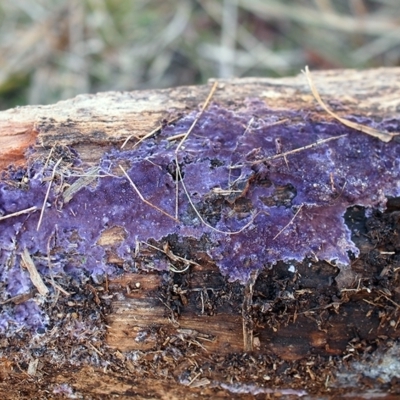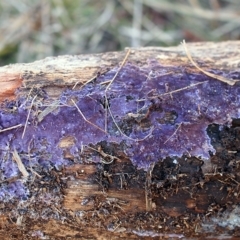Phlebiopsis crassa (A corticioid or paint fungi)
This is one of the corticioid fungi (or, colloquially, ‘paint fungi’) and you find it mostly on the underside of dead wood that is lying on the ground. The fruit body is two-dimensional and from a distance looks like a wash of purplish paint on the wood. A closer look shows it to have a brief whitish margin, then a pale purple and darker further away from the margin. With age the colour becomes a dull purplish-brown (though the purplish colour tends to persist near the margin) and may become cracked. If you look at this with a hand lens you see that the surface has a velvety appearance and the texture is softish.
Fruit bodies start as small patches, often many close together and, as each expands, neighbouring fruit bodies may merge so that over time an irregularly shaped purplish sheet develops on the wood. A well-developed sheet may be only a few square centimetres in area but occasionally you see a sheet covering a square metre or so.
The name change to Phlebiopsis crassa occurred in 2015, following the molecular analysis of a certain group of corticioid fungi. Before that other fairly recent names for this species were Hjortstamia crassa, Porostereum crassum and Lopharia crassa.
This species is known from many parts of the world.
Any look-alikes?
When it has the rich purple colours this species is unmistakeable but when the colour turns brownish then you’ll have problem since there are other brownish, velvety corticoid fungi.
There are some flat, purplish polypores that turn up on the underside of dead wood – but they have numerous tiny pores (and you may need a magnifying glass or hand lens to see them). This Hypoxylon (https://canberra.naturemapr.org/Community/Sighting/3401717) is similar in colour but hard and non-velvety.
Phlebiopsis crassa is listed in the following regions:
Canberra & Southern Tablelands | South Coast
Species information
- Phlebiopsis crassa Scientific name
- A corticioid or paint fungi Common name
- Not Sensitive
- Local native
- Non-invasive or negligible
- Up to 642m Recorded at altitude
- Machine learning


























